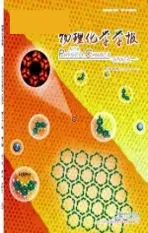锌掺杂提高LiNi1/3Co1/3Mn1/3O2正极材料的电化学稳定性
2012-12-11李节宾徐友龙杜显锋孙孝飞熊礼龙
李节宾 徐友龙 杜显锋 孙孝飞 熊礼龙
(1西安交通大学,电子陶瓷与器件教育部重点实验室,国际电介质研究中心,西安710049; 2陕西应用物理化学研究所,西安710061)
锌掺杂提高LiNi1/3Co1/3Mn1/3O2正极材料的电化学稳定性
李节宾1,2徐友龙1,*杜显锋1孙孝飞1熊礼龙1
(1西安交通大学,电子陶瓷与器件教育部重点实验室,国际电介质研究中心,西安710049;2陕西应用物理化学研究所,西安710061)
通过共沉淀法与固相法相结合制备了掺锌的高稳定性Li(Ni1/3Co1/3Mn1/3)1-xZnxO2(x=0,0.02,0.05)正极材料.循环伏安(CV)曲线表明Zn掺杂使氧化峰与还原峰的电势差减小到0.09 V,电化学阻抗谱(EIS)曲线表明Zn掺杂使电极的阻抗从266 Ω减小到102 Ω.Li+嵌入扩散系数从1.20×10-11cm2·s-1增大到2.54×10-11cm2· s-1.Li(Ni1/3Co1/3Mn1/3)0.98Zn0.02O2正极材料以0.3C充放电在较高的截止电压(4.6 V)下比其他两种材料的电化学循环性能更稳定,其第二周的放电比容量为176.2 mAh·g-1,室温下循环100周后容量几乎没衰减;高温(55°C)下充放电循环100周,其放电比容量平均每周仅衰减0.20%,远小于其他两种正极材料(LiNi1/3Co1/3Mn1/3O2平均每周衰减0.54%;Li(Ni1/3Co1/3Mn1/3)0.95Zn0.05O2平均每周衰减0.38%).Li(Ni1/3Co1/3Mn1/3)0.98Zn0.02O2正极材料以3C充放电时其放电比容量可达142 mAh·g-1,高于其他两种正极材料.电化学稳定性的提高归因于Zn掺杂后减小了电极的极化和阻抗,增大了锂离子扩散系数.
LiNi1/3Co1/3Mn1/3O2; 高截止电压;Zn掺杂; 正极材料; 锂离子电池
1 Introduction
Since the layered transition metal oxide LiNi1/3Co1/3Mn1/3O2was initially proposed by Ohzuku and Makimura1in 2001,it has been extensively studied2-7due to its higher reversible capacity,lower cost,less toxicity,and enhanced safety features compared to conventional LiCoO2.The LiNi1/3Co1/3Mn1/3O2powder has a typical hexagonal α-NaFeO2structure with a space group of R3m.Its reversible capacity comes from the redox reactions associated with the Ni2+/3+,Ni3+/4+,and Co3+/4+couples.8-11 The LiNi1/3Co1/3Mn1/3O2cathode material can deliver a high capacity of ca 200 mAh·g-1when it is charged to 4.6 V(vs Li/ Li+).12-16It is considered to be one of the best candidate cathode materials for high-power applications,such as electric vehicles (EVs)and hybrid electric vehicles(HEVs).8
However,there are still two important problems limiting the applications of LiNi1/3Co1/3Mn1/3O2cathode material in highpower lithium ion batteries.One is the serious capacity fading, especially if cycled at 4.6 V(vs Li/Li+);10-13the other is its poor rate capacity due to its low Li ion diffusion as well as the electronic conductivity.14-16It is thought that doping of LiCoO2by a transition metal ion results in a capacity increase while non-transition metal ion doping results in a voltage increase at the expense of capacity.17,18To overcome both problems of LiNi1/3Co1/3Mn1/3O2cathode material,one significant approach is doping by other transition metals such as Ti,Cr or non-transition metals such asAl,Mg.13,19-21
Since Zn is chemically similar to magnesium in some aspects,22it has been used to improve the electrochemical properties of LiNi0.8-xCo0.2ZnxO223and LiNixCo1/3Mn1/3ZnxO2.18However,the electrochemical stabilities of Li(Ni1/3Co1/3Mn1/3)1-xZnxO2cathode materials are few studied at high cut-off voltages(eg. 4.6 V,vs Li/Li+).
In this work,the Li(Ni1/3Co1/3Mn1/3)1-xZnxO2(x=0,0.02,0.05) cathode materials have been synthesized by solid-state approaches with co-precipitated precursors.The effects on structures,morphologies,and electrochemical properties at high cut-off voltage were investigated in detail.
2 Experimental
2.1 Synthesis of Li(Ni1/3Co1/3Mn1/3)1-xZnxO2(x=0,0.02,0.05)cathode materials
The M3O4(M=Ni1/3Co1/3Mn1/3)powder was prepared by sintering co-precipitated M(OH)2at 500°C,which was reported in the previous paper.24Stoichiometric amounts of LiOH·H2O (99.5%)and different amounts of nanoscale ZnO(Shanghai Shanghui Nano Co.,molar ratios of M:0%,2%,5%)were added to M3O4and ball-milled for 24 h.The mixtures were then sintered at 850°C for 24 h in an air furnace to synthesize Li(Ni1/3Co1/3Mn1/3)1-xZnxO2(x=0,0.02,0.05)materials,which were marked by Zn0,Zn2,and Zn5,respectively.
2.2 Cathode material characterization
The powder X-ray diffraction(XRD)measurement was carried out on a PANalytical,XʹPert PRO X diffractometer equipped with a Cu Kαradiation(λ=0.154056 nm).The 2θ Bragg angles were scanned over a range of 10°-80°.Lattice parameters were investigated by XRD with the XʹPert Highscore Pluse software.Scanning electron microscope(SEM) was performed using a JSM-6700F.Atomic absorption spectroscopy analysis(analytikjenaAG AAS,NoV AA 300)was performed to investigate the real chemical composition of Zn element.
The electrochemical properties of Li(Ni1/3Co1/3Mn1/3)1-xZnxO2(x=0,0.02,0.05)cathode materials were examined in CR2016 coin type cells.The cathode electrodes were prepared by pasting the mixture of 70%(mass fraction)cathode materials,20% acetylene black,and 10%PVDF(ARKEMA,Kynar)on an aluminum foil current collector.The electrolyte was 1 mol·L-1LiPF6/ethylene carbonate(EC)+diethyl carbonate(DEC)+ethyl methyl carbonate(EMC)(Shenzhen Capchem Technology Co., LTD,1:1:1 in volume ratio).Lithium metal foil was used as negative electrode.The cells were assembled in a Mikrouna Super(1225/750)glove box under a dry argon atmosphere and then aged for 10 h before initial charge to ensure full absorption of the electrolyte into the electrode.Both cyclic voltammetry(CV)tests and electrochemical impedance measurements (EIS)were performed using Versatile Multichannel Potentiostat 2/Z with the ability for impedance measurements(Bio-logic).The CV measurements were tested in the potential range of 2.8-4.7 V using the galvanostatic mode at a scan rate of 0.1 mV·s-1.The EIS measurements frequency range was from 100 kHz to 10 mHz at 3.6 V.Charge/discharge characteristics were tested galvanostatically in the voltage of 2.8-4.6 V(vs Li/Li+) by LAND Battery Test System.
3 Results and discussion
3.1 Physical and chemical performances
Zn contents were determined by atomic absorption spectroscopy analysis and the x values have been determined to be 0, 1.26%,and 3.21%,which are closed to the calculated theoretic values.
The structures of Zn doped LiNi1/3Co1/3Mn1/3O2materials were measured by XRD,as shown in Fig.1.The materials can be indexed based on hexagonal α-NaFeO2structure.There is no obvious diffraction peak for new phases,suggesting that their crystal structures are hardly changed by Zn-doping.The absence of diffraction patterns corresponding to Zn compounds is due to the low doped Zn-content.23The diffraction patterns show clear splitting of the hexagonal characteristic doublets (006)/(102)and(108)/(110),indicating that the products possess typical layered characteristics.25,26The lattice parameters of a,c,c/a and the unit cell volumes(V)for all the cathode materials are summarized in Table 1.The V,c,and c/a of the samples slightly increase with the Zn-doped content.The expansions of V and c indicate that Zn2+ions have doped in ZnO during the heat-treatment process because the radius of Zn2+(0.074 nn)is less than that of Li+(0.076 nm)while larger than that of Ni2+(0.069 nm),Co3+(0.0545 nm),and Mn4+(0.054 nm).It means that the distance DLi-Oand the interslab thickness I(LiO2)increase and lead to the increase of the electrostatic repulsions between the slabs when lithium ions are deintercalated from the interslab,which is corresponding to the effect of magnesium doping on lithium nickel cobalt oxide by Pouillerie et al.27
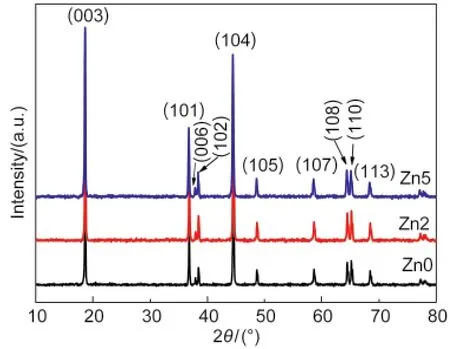
Fig.1 XRD patterns of the Li(Ni1/3Co1/3Mn1/3)1-xZnxO2 (x=0,0.02,0.05)powders
In Fig.2,the SEM images of Zn0,Zn2,and Zn5 show similar morphologies.The powders mainly consist of agglomerated particles with primary particles of 200-300 nm.Hence,Zn doping does not change their morphologies.

Table 1 Lattice parameters of the Li(Ni1/3Co1/3Mn1/3)1-xZnxO2 (x=0,0.02,0.05)powders
3.2 Electrochemical performances
CV and EIS were carried out to investigate the electrochemical performances of the Zn-doped Li(Ni1/3Co1/3Mn1/3)1-xZnxO2cathode materials.Fig.3 shows the cyclic voltammograms of Li(Ni1/3Co1/3Mn1/3)1-xZnxO2(x=0,0.02,0.05)cathode materials between 2.8 and 4.7 V at a scan rate of 0.1 mV·s-1for the second cycle.The anodic and cathodic peaks center at around 3.80 and 3.64 V for Zn0,3.79 and 3.70 V for Zn2,3.81 and 3.70 V for Zn5,respectively,corresponding to the Ni2+/Ni4+redox couple.These results suggest that there is no structural transitions from hexagonal to monoclinic during the charge/discharge between 2.8 and 4.6 V.28As shown in Fig.3,the voltage differences between the oxidation and reduction are 0.09 V for Zn2 and 0.11 V for Zn5,which are less than that(0.16 V)for Zn0. Thus,a little Zn doping reduces the polarization possibly due to improved structure order of the materials.
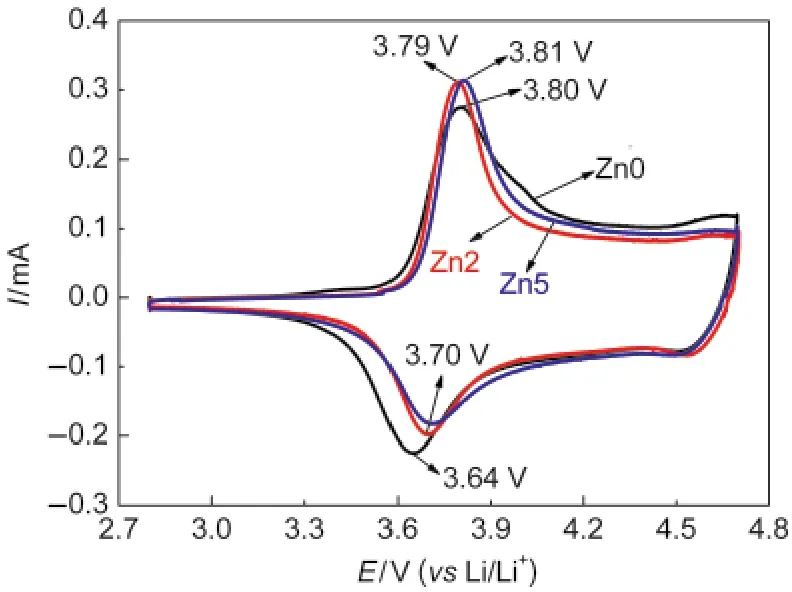
Fig.3 Cyclic voltammograms of the Li(Ni1/3Co1/3Mn1/3)1-xZnxO2 (x=0,0.02,0.05)cathode materials between 2.8 and 4.7 V at a scan rate of 0.1 mV·s-1The voltage differences between the oxidation and reduction are 0.09 V for Zn2,0.11 V for Zn5,and 0.16 V for Zn0.

Fig.2 SEM images of the Li(Ni1/3Co1/3Mn1/3)1-xZnxO2(x=0,0.02,0.05)powdersThe powders mainly consisted of agglomerated particles with primary particles of 200-300 nm.
In order to test the effect of Zn doping on lithium ion transport through LiNi1/3Co1/3Mn1/3O2electrode,CV technique was carried out.Generally,CV measurement is a typical method to evaluate the apparent diffusion coefficient of Li ions in electrode materials.29,30Fig.4a shows a group of CV curves of Zn2 sample at various scan rates from 0.3 to 1.5 mV·s-1.There are two clear oxidation/reduction peaks,corresponding to the ma-jor oxidation/reduction reactions during Li deintercalation/intercalation in Zn2.The peak current(Ip)increases with the increasing scan rate,the cathodic peaks shift to lower potential, and the anodic peaks shift to higher potential.The peak current (Ip)versus v1/2are plotted in Fig.4b,showing that the peak current Ipexhibits a linear relationship with v1/2due to semi-infinite diffusion controlled process.At relatively higher scan rates,the chemical diffusion coefficient of Li ions can be calculated from the Randles-Sevcik equation,which can be expressed as follows:31
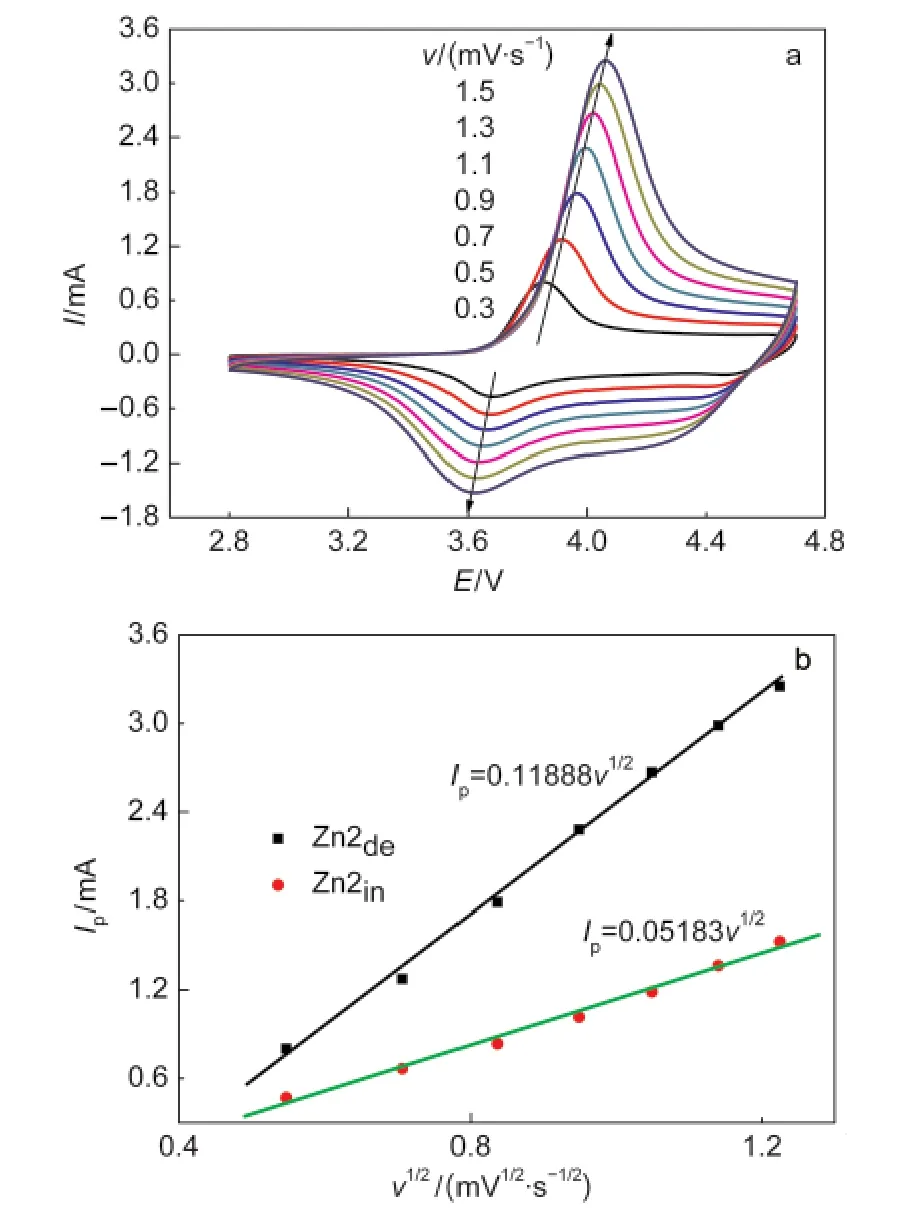
Fig.4 (a)CV curves of Zn2 between 2.8 and 4.7 V at different scan rates(v)and(b)square root of scan rate dependence of the peak current Ipfor Zn2

where A is the active electrode area(0.785 cm2),C*Liis the bulk concentration of Li in electrode(0.0487 mol·cm-3),v is the potential scan rate(V·s-1),DLiis the chemical diffusion coefficient of Li ions in the film(cm2·s-1),and n is the charge-transfer number.Based on Eq.(1),the chemical diffusion coefficients of Li ion are estimated to be 2.54×10-11cm2·s-1for Li ion intercalation process and 13.34×10-11cm2·s-1for Li ion deintercalation process.Using the same method,the Li ion diffusion coefficients of Zn0 and Zn5 are calculated and listed in Table 2.It can be seen that Zn2 has the highest diffusion coefficients of Li ions,meaning that partial transition metal ion substituted by Zn ions leads to higher Li ion diffusion coefficients and promotes lithium transportation.The increased Li ion diffusion coefficient can be attributed to the larger cell size and parameter c caused by Zn doping,which is favorable for lithium ion migration.

Table 2 Li ion diffusion coefficients of the Li(Ni1/3Co1/3Mn1/3)1-xZnxO2(x=0,0.02,0.05)cathode materials
The impedances are evaluated at 3.6 V after 10 cycles by EIS.The EIS curves of Li(Ni1/3Co1/3Mn1/3)1-xZnxO2(x=0,0.02, 0.05)electrodes are described in Fig.5.All curves include a semicircle in the high-frequency and intermediate frequency region,and an inclined line in the low-frequency region.The semicircle comes from the contact resistance at the composite cathode and the charge transfer reaction at the interface of the cathode/electrolyte,and the inclined line in the lower frequency range is attributed to Warburg impedance that is associated with Li ion diffusion through the cathode.The impedance of Zn2 is 102 Ω,which is less than other two materials,viz.266 Ω for Zn0 and 149 Ω for Zn5.The lower impedance for Zn2 indicates the better intercalation-deintercalation of Li ion in Zn2 matrix,which can be attributed to slightly increasing in unit cell volume and facilitating Li ion intercalation-deintercalation from the oxide structure.It was known that the electrochemical performance of cathode materials may be ascribed to electrode polarization,impedance,and Li ion diffusion coefficients,14,32,33which are improved by Zn doping.
The galvanostatic charge/discharge tests were carried out to study the electrochemical performances.Fig.6 shows the second charge/discharge curves of the Li(Ni1/3Co1/3Mn1/3)1-xZnxO2(x=0,0.02,0.05)cells evaluated at 0.3C(LiNi1/3Co1/3Mn1/3O2: 1C≈150 mAh·g-1;Li(Ni1/3Co1/3Mn1/3)0.98Zn0.02O2:1C≈160 mAh· g-1;Li(Ni1/3Co1/3Mn1/3)0.95Zn0.05O2:1C≈130 mAh·g-1)between 2.8 and 4.6 V at room temperature.It can be seen that the charge/discharge capacities are 226.2/189.0 mAh·g-1for Zn0, 181.4/176.2 mAh·g-1for Zn2,and 155.8/141.1 mAh·g-1for Zn5.Correspondingly,the irreversible capacities are 37.2,5.2, and 14.7 mAh·g-1,and the charge/discharge efficiencies are 83.5%,97.1%,and 90.6%,respectively.The decrease of charge/discharge capacity by Zn-doping may be ascribed to Zn2+with large radius blocking the Li+intercalation-deintercala-tion path or reducing a bulk concentration of Ni2+.34Although Zn-doping decreases the capacities of the initial several cycles, Zn2 and Zn5 exhibit greater charge/discharge efficiencies than Zn0 because of the sabilized structure by Zn doping.Therefore,the reversibility of LiNi1/3Co1/3Mn1/3O2cathode material at high cut-off voltage(4.6 V)is enhanced.
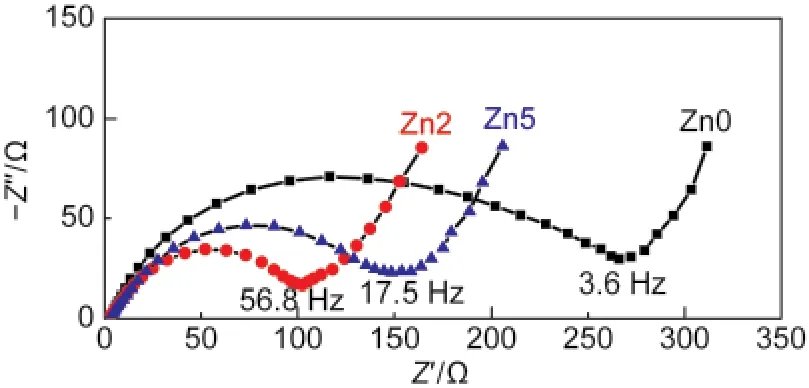
Fig.5 Electrochemical impedance spectroscopies of the Li(Ni1/3Co1/3Mn1/3)1-xZnxO2(x=0,0.02,0.05)electrodes at 3.6 VThe impedances are evaluated at 3.6 V after 10 cycles and are 266 Ω for Zn0,102 Ω for Zn2,and 149 Ω for Zn5.
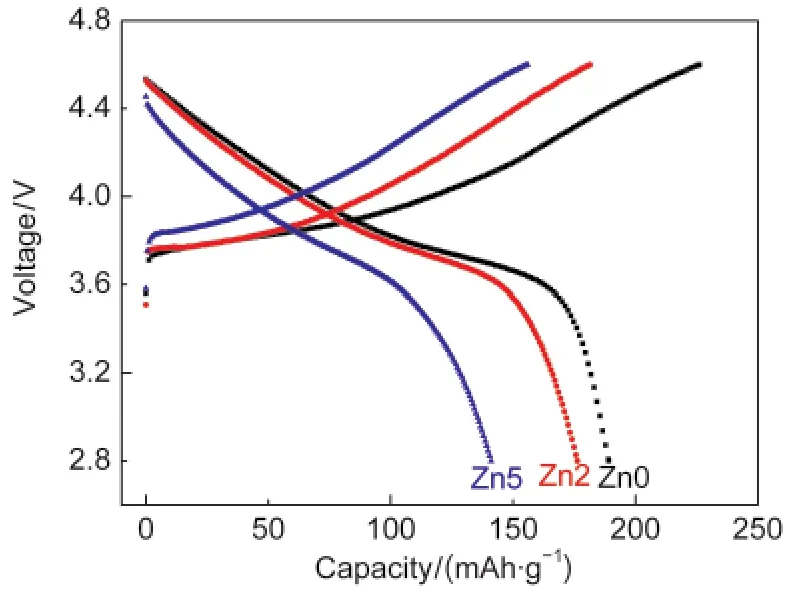
Fig.6 The second charge/discharge curves of the Li(Ni1/3Co1/3Mn1/3)1-xZnxO2(x=0,0.02,0.05)at the rate of 0.3C over a voltage range of 2.8-4.6 VThe charge/discharge capacities are 226.2/189.0 mAh·g-1for Zn0,181.4/ 176.2 mAh·g-1for Zn2,and 155.8/141.1 mAh·g-1for Zn5.
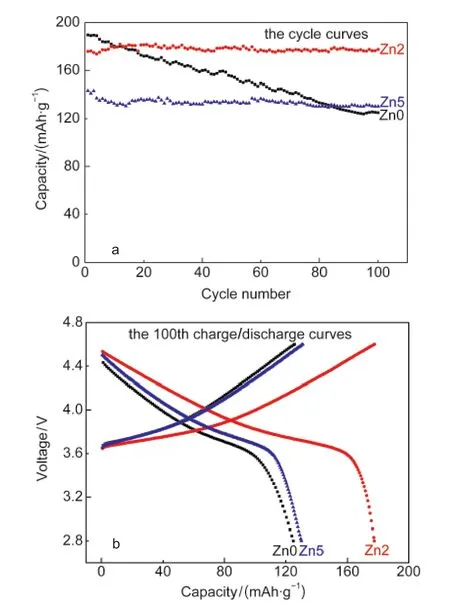
Fig.7 Cycling performances of the Li(Ni1/3Co1/3Mn1/3)1-xZnxO2 (x=0,0.02,0.05)cathode materials operating at 0.3C between 2.8 and 4.6 V at room temperature
The cycling performances of the Li(Ni1/3Co1/3Mn1/3)1-xZnxO2(x=0,0.02,0.05)cathode materials operating at the 0.3C rate between 2.8 and 4.6 V at room temperature are shown in Fig.7. From Fig.7a,the discharge capacity of Zn0 displays a severe capacity fading during cycling and the capacity retention is only 65.9%after 100 cycles.The capacity loss results from the Co dissolution into the electrolyte at high cut-off voltage.35However,the cycling performance of Zn2 is very stable,showing no appreciable drop after 100 cycles.It is clearly shown that the cycling performance of LiNi1/3Co1/3Mn1/3O2cathode materials is improved by Zn-doping.Since the binding energy of Zn(2p3/2)(1021.8 eV)36is much larger than that of Ni(2p3/2) (854.0 eV),Co(2p3/2)(779.5 eV),and Mn(2p3/2)(642.2 eV),3Zn-doping leads to stabilizing the structures of the cathode materials and reducing the Co dissolution into the electrolyte at high cut-off voltages.Furthermore,the stronger Zn-O bond means the weaker Li-O bond,which is favorable to lithium ion migration.30,37Fig.7b compares the variation of the 100th charge/discharge curves.Little irreversible capacities are observed in all samples.The separation between charge and discharge curves of Zn2 is small,indicating almost no polarzation along with cycling.Therefore,the electrochemical stabilities are improved by Zn-doping.
The impedances of Zn0,Zn2,and Zn5 are measured at 3.6 V after 100 cycles by EIS,as shown in Fig.8.The impedance of Zn2 is 61 Ω,and that of Zn5 is 75 Ω.The impedances of Zn2 and Zn5 decrease largely with cycling;while that of Zn0 is more than 1000 Ω,which increases with cycling.It means that using 2%Zn2+doping can stabilize the structures of cathode materials,therefore,reduces the impedance and increases the Li ion migration.
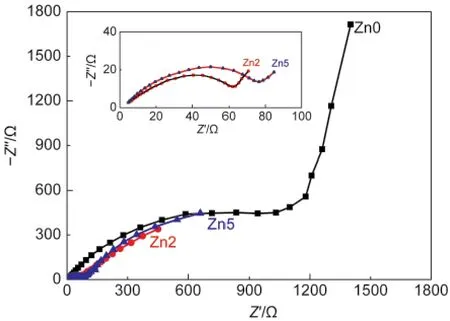
Fig.8 Electrochemical impedance spectroscopies of the Li(Ni1/3Co1/3Mn1/3)1-xZnxO2(x=0,0.02,0.05)electrodes after 100 cycles at room temperatureThe impedances are measured at 3.6 V in 100 cycles and are 1031 Ω for Zn0,61 Ω for Zn2,and 75 Ω for Zn5,respectively.
The test temperature is a key factor for the performance of the Li-ion cells.The faster degradation of cathode material would occur at higher test temperature.38Fig.9 displays the cycling performance at 0.3C rate under 55°C at the voltage range of 2.8-4.6 V after 5 cycles at room temperature.The discharge capacities of all samples are greatly improved at 55°C, which can be attributed to the higher Li ion diffusion rate at high temperature.However,the capacity retentions decrease obviously.From Fig.9a,the discharge capacity of Zn0 declines fast,with an average capacity loss of 0.54%per cycle in 100 cycles.In contrast,the average discharge capacity losses are only 0.20%and 0.38%per cycle for Zn2 and Zn5 in 100 cycles,respectively.Fig.9b shows the Zn0 and Zn2 charge/discharge curves of the initial and 100th cycles at 55°C.The irreversible capacity for Zn2 is 46 mAh·g-1,which is less than the value of 137 mAh·g-1for Zn0.The 100th charge and discharge curves diverge greatly,which indicates that the electrode polarizations develop on cycling at high temperature.The increasing electrode polarizations can lead to degradation in capacities.Furthermore,the severe capacity fading can also result from the lithium dendrite from irreversible lithium-ion deposition on the anode and the decomposition of the electrolyte on the surface of cathode materials at high cut-off voltages and high temperatures.Chenʹs research results suggest that Zn-doping can largely reduce the exothermic heat amount and improve the thermal decomposition temperature of cathode materials.19Therefore,Zn-doping can not only reduce electrode polarizations and the decomposition of the electrolyte on the surface of cathode materials but also stabilize the structure of cathode materials at high temperature(55°C).
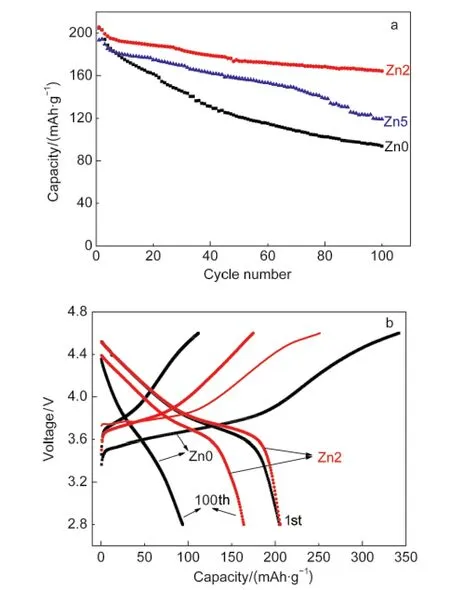
Fig.9 Cycling performances of the Li(Ni1/3Co1/3Mn1/3)1-xZnxO2 (x=0,0.02,0.05)cathode materials operating at 0.3C between 2.8 and 4.6 V at 55°C(a)the cycle curves;(b)the 100th charge/discharge curves of Zn0 and Zn2
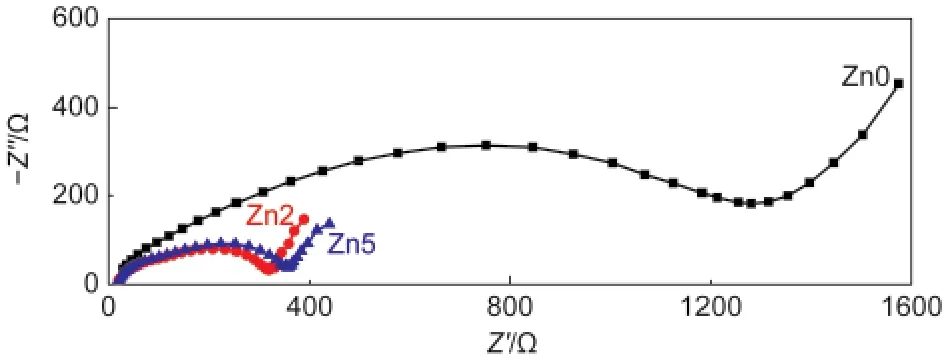
Fig.10 Electrochemical impedance spectroscopies of theLi(Ni1/3Co1/3Mn1/3)1-xZnxO2(x=0,0.02,0.05)electrodes after 100 cycles at 55°CThe impedances are 1279 Ω for Zn0,314 Ω for Zn2,and 358 Ω for Zn5,respectively.
After 100 cycles at high temperature,the impedances of Zn0,Zn2,and Zn5 are evaluated at 3.6 V(seen in Fig.10)under room temperature.Although the ex-situ EIS can not provide the real impedance of these cathodes after high temperature cycling,it still shows that Zn2 has the lowest impedance even side reactions and lithium detritions are possibly happened at high temperatures.Moreover,the impedance increase compared to Fig.5 is smaller in Zn doped materials.Our further work is undergoing to study the detailed impedance increase in Fig.10,but the present results also illuminate the more stable cyclability of Zn2 at 55°C.
High rate performance is one of the significant electrochemicalcharacteristicsoflithium ion batteriesrequired for high-power applications.Fig.11 displays the cycling behavior and rate capability of the Li(Ni1/3Co1/3Mn1/3)1-xZnxO2(x=0,0.02, 0.05)cathode materials at various discharge rates of 0.1C, 0.3C,0.6C,1.5C,and 3C between 2.8 and 4.6 V at room temperature(charged and discharged at the same rate for each test).For Zn2 and Zn5,the initial discharge capacities are 185 and 158 mAh·g-1at 0.1C respectively,while that of Zn0 is 198 mAh·g-1.When the discharge rate reaches to 3C,the discharge capacity of Zn2 is 142 mAh·g-1,which is higher than those of Zn0(129 mAh·g-1)and Zn5(108 mAh·g-1).The higher discharge capacity at higher rate can be related to the much stable layer structure of cathode materials by Zn-doping.After discharging at 3C rate,all the cells are cycled at 0.1C again.Zn2 and Zn5 show better recoverability in discharge capacity, which is consistent with the result in Fig.7a.
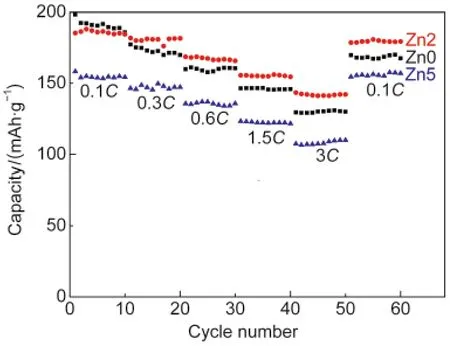
Fig.11 Cycling behaviors and rate capability test of the Li(Ni1/3Co1/3Mn1/3)1-xZnxO2(x=0,0.02,0.05)cathode materials at various discharge rates between 2.8 and 4.6 V
4 Conclusions
In this work,the Li(Ni1/3Co1/3Mn1/3)1-xZnxO2(x=0,0.02,0.05) cathode materials have been synthesized by the solid-state approaches with co-precipitated precursors.It is found that Li(Ni1/3Co1/3Mn1/3)0.98Zn0.02O2has the most stable cycling capability during constant charge/discharge at high cut-off voltage (4.6 V).There is almost no capacity decay after 100 cycles at room temperature and the average capacity loss is only 0.20% per cycle in 100 cycles at high temperature(55°C).It can still deliver a discharge capacity of 142 mAh·g-1at 3C.Reduced electrode polarization,decreased impedance,increased lithium ion diffusion,and excellent cycling performance are attributed to the stable structure of Zn doped LiNi1/3Co1/3Mn1/3O2.
(1)Ohzuku,T.;Makimura,Y.Chem.Lett.2001,7,642.
(2) Hwang,B.J.;Tsai,Y.W.;Carlier,D.;Ceder,G.Chem.Mater. 2003,15,3676.doi:10.1021/cm030299v
(3) Shaju,K.M.;Rao,G.V.S.;Chowdari,B.V.R.Electrochim. Acta 2002,48,145.doi:10.1016/S0013-4686(02)00593-5
(4)Wu,F.;Wang,M.;Su,Y.F.;Chen,S.Acta Phys.-Chim.Sin. 2009,25,629.[吴 峰,王 萌,苏岳峰,陈 实.物理化学学报,2009,25,629.]doi:10.3866/PKU.WHXB20090411
(5)Tu,J.P.;Wu,H.M.;Chen,X.T.;Yuan,Y.F.;Li,Y.;Zhao,X. B.;Cao,G.S.J.Power Sources 2006,159,291.doi:10.1016/j. jpowsour.2006.04.032
(6) Chen,J.;Wang,S.;Whittingham,M.S.J.Power Sources 2007, 174,442.doi:10.1016/j.jpowsour.2007.06.189
(7)Reddy,M.V.;Rao,G.V.S.;Chowdari,B.V.R.J.Power Sources 2006,159,263.doi:10.1016/j.jpowsour.2006.04.134
(8)Koyama,Y.;Tanaka,I.;Adachi,H.;Makimura,Y.;Ohzuku,T. J.Power Sources 2003,119,644.doi:10.1016/S0378-7753(03) 00194-0
(9)Yoon,W.S.;Grey,C.P.;Balasubramanian,M.;Yang,X.Q.; Fischer,D.A.;McBreen,J.Electrochem.Solid State Lett.2004, 7,A53.
(10) Kim,J.M.;Chung,H.T.Electrochim.Acta 2004,49,937.doi: 10.1016/j.electacta.2003.10.005
(11)Shaju,K.M.;Rao,G.V.S.;Chowdari,B.V.R.J.Electrochem. Soc.2004,151,A1324.
(12) Yabuuchi,N.;Ohzuku,T.J.Power Sources 2003,119,171.doi: 10.1016/S0378-7753(03)00173-3
(13)Chebiam,R.V.;Prado,F.;Manthiram,A.Chem.Mater.2001, 13,2951.doi:10.1021/cm0102537
(14)Kim,H.S.;Kong,M.;Kim,K.;Kim,I.J.;Gu,H.B.J.Power Sources 2007,171,917.doi:10.1016/j.jpowsour.2007.06.028
(15) Na,S.H.;Kim,H.S.;Moon,S.I.Solid State Ionics 2005,176, 313.doi:10.1016/j.ssi.2004.08.016
(16)Sun,Y.K.;Lee,Y.S.;Yoshio,M.;Amine,K.Electrochem.Solid State Lett.2002,5,L1.
(17) Ceder,G.;Chiang,Y.M.;Sadoway,D.R.;Aydinol,M.K.;Jang, Y.I.;Huang,B.Nature 1998,392,694.doi:10.1038/33647
(18)Zou,M.J.;Yoshio,M.;Gopukumar,S.;Yamaki,J.Chem. Mater.2003,15,4699.doi:10.1021/cm0347032
(19)Chen,Y.H.;Chen,R.Z.;Tang,Z.Y.;Wang,L.J.Alloy.Compd. 2009,476,539.doi:10.1016/j.jallcom.2008.09.055
(20) Ren,H.B.;Li,X.;Peng,Z.H.Electrochim.Acta 2011,56, 7088.doi:10.1016/j.electacta.2011.05.104
(21) Milewska,A.;Molenda,M.;Mokenda,J.Solid State Ionics 2011,192,313.doi:10.1016/j.ssi.2010.11.026
(22) Holleman,A.F.;Wiberg,E.;Wiberg,N.Lehrbuch der Anorganischen Chemie;Gruyter:Berlin,1995.
(23) Fey,G.T.K.;Chen,J.G.;Subramanian,V.;Osaka,T.J.Power Sources 2002,112,384.doi:10.1016/S0378-7753(02)00400-7
(24) Li,J.B.;Xu,Y.L.;Xiong,L.L.;Wang,J.P.Acta Phys.-Chim. Sin.2011,27,2593.[李节宾,徐友龙,熊礼龙,王景平.物理化学学报,2011,27,2593.]doi:10.3866/PKU.WHXB20111104
(25) Jouanneau,S.;Eberman,K.W.;Krause,L.J.;Dahn,J.R. J.Electrochem.Soc.2003,150,A1637.
(26) Kim,J.H.;Yoon,C.S.;Sun,Y.K.J.Electrochem.Soc.2003, 150,A538.
(27) Pouillerie,C.;Perton,F.;Biensan,P.;Peres,J.P.;Broussely,M.; Delmas,C.J.Power Sources 2001,96,293.doi:10.1016/ S0378-7753(00)00653-4
(28) Liu,L.;Sun,K.N.;Zhang,N.Q.;Yang,T.Y.J.Solid State Electrochem.2009,13,1381.doi:10.1007/s10008-008-0695-z
(29) Xia,H.;Lu,L.;Lai,M.O.Electrochim.Acta 2009,54,5986. doi:10.1016/j.electacta.2009.02.071
(30) Xiong,L.L.;Xu,Y.L.;Zhang,C.;Zhang,Z.W.;Li,J.B. J.Solid State Electrochem.2011,15,1263.doi:10.1007/ s10008-010-1195-5
(31) Bard,A.J.;Faulkner,L.R.Electrochemical Methods,2nd ed.; Wiley:New York,2001.
(32)Jiao,L.F.;Zhang,M.;Yuan,H.T.;Zhao,M.;Guo,H.;Wang, W.;Zhou,X.D.;Wang,Y.M.J.Power Sources 2007,167,178. doi:10.1016/j.jpowsour.2007.01.070
(33) Ghosh,P.;Mahanty,S.;Basu,R.N.Electrochim.Acta 2009,54, 1654.doi:10.1016/j.electacta.2008.09.050
(34) Malik,R.;Burch,D.;Bazant,M.;Ceder,G.Nano Lett.2010, 10,4123.doi:10.1021/nl1023595
(35) Hwang,B.J.;Santhanam,R.;Chen,C.H.J.Power Sources 2003,114,244.doi:10.1016/S0378-7753(02)00584-0
(36) Kyu-Hang,L.;Nam-In,C.;Eui-Jung,Y.;Nam,H.G.Appl.Surf. Sci.2011,256,4241.
(37) Katsumata,T.;Matsui,Y.;Inaguma,Y.;Itoh,M.Solid State Ionics 1996,86(8),165.
(38)Wu,F.;Wang,M.;Su,Y.F.;Bao,L.Y.;Chen,S.Electrochim. Acta 2009,54,6803.doi:10.1016/j.electacta.2009.06.075
March 15,2012;Revised:May 14,2012;Published on Web:May 15,2012.
Improved Electrochemical Stability of Zn-Doped LiNi1/3Co1/3Mn1/3O2Cathode Materials
LI Jie-Bin1,2XU You-Long1,*DU Xian-Feng1SUN Xiao-Fei1XIONG Li-Long1
(1International Center for Dielectric Research,Electronic Materials Research Laboratory of the Ministry of Education,Xiʹan Jiaotong University,Xiʹan 710049,P.R.China;2Shaanxi Applied Physics and Chemistry Research Institute; Xiʹan 710061,P.R.China)
Highly stable Li(Ni1/3Co1/3Mn1/3)1-xZnxO2(x=0,0.02,0.05)cathode materials doped with Zn are synthesized by solid-state reactions with co-precipitated precursors.Cyclic voltammetry(CV)curves reveal thatthe potentialdifference between oxidation and reduction decreasesto 0.09 V,and from electrochemical impedance spectra(EIS)curves,the impedance of LiNi1/3Co1/3Mn1/3O2cathode materials is reduced from 266 to 102 Ω.The diffusion coefficients of Li+ions in intercalation processes increase from 1.20×10-11to 2.54×10-11cm2·s-1.Li(Ni1/3Co1/3Mn1/3)0.98Zn0.02O2is stable at 0.3C(constant charge/discharge)at a high cut-off potential of 4.6 V vs Li/Li+.It has a second discharge capacity of 176.2 mAh·g-1at 0.3C and 142 mAh·g-1at 3C,and keep almost no decay after 100 cycles at room temperature.Furthermore,its average capacity loss per cycle at 55°C is 0.20%,which is lower compared with 0.54%for LiNi1/3Co1/3Mn1/3O2and 0.38%for Li(Ni1/3Co1/3Mn1/3)0.95Zn0.05O2after 100 cycles.The improved electrochemical stability of Zn-doped LiNi1/3Co1/3Mn1/3O2is attributed to the reduced electrode polarization and impedance values,and an increased Li+ion diffusion coefficient.
Lithium nickel cobalt manganese oxide;High cut-off voltage;Zn-doping;Cathode material; Lithium ion battery
10.3866/PKU.WHXB201205152
∗Corresponding author.Email:ylxuxjtu@mail.xjtu.edu.cn;Tel:+86-29-82665161.
The project was supported by the National Natural Science Foundation of China(50902109).
国家自然科学基金(50902109)资助项目
O646
